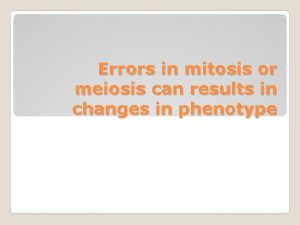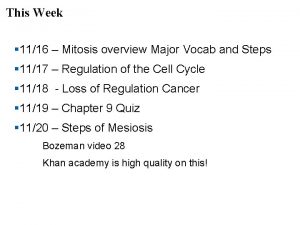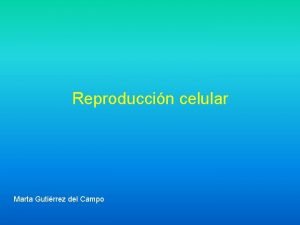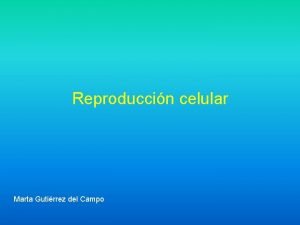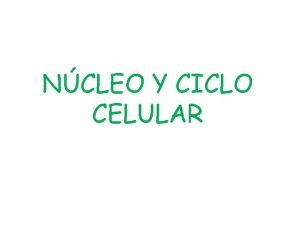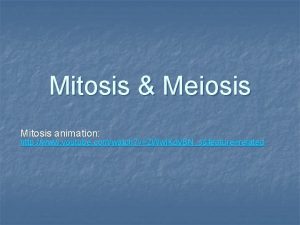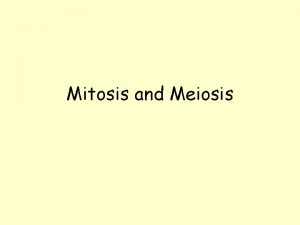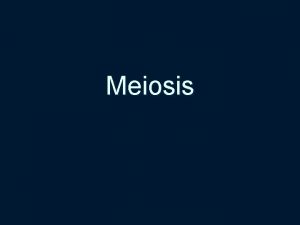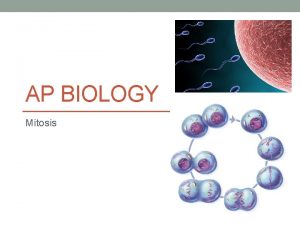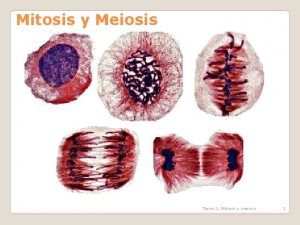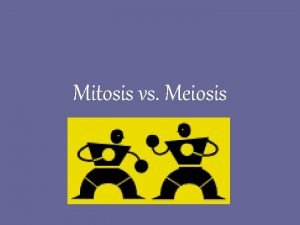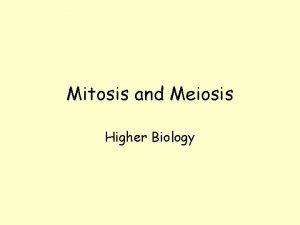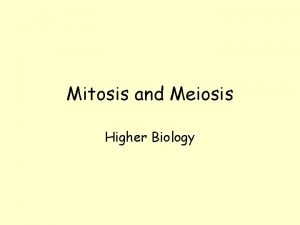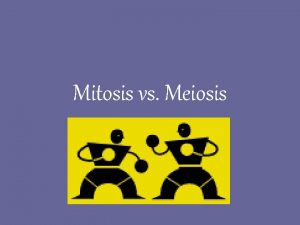Errors in mitosis or meiosis can results in









- Slides: 9

Errors in mitosis or meiosis can results in changes in phenotype

�Breakage of a chromosome can lead to four types of changes in chromosome structure: ◦ Deletion removes a chromosomal segment ◦ Duplication repeats a segment ◦ Inversion reverses a segment within a chromosome ◦ Translocation moves a segment from one chromosome to another Alteration of Chromosome Structure

Fig. 15 -15 (a) (b) (c) (d) A B C D E F G H A B Duplication A B C D E F G H Deletion A B Inversion C E F G H C B C D A D C B E M N O C D Reciprocal translocation M N O P Q R A B P Q R E F G H

�In nondisjunction, pairs of homologous chromosomes do not separate normally during meiosis �As a result, one gamete receives two of the same type of chromosome, and another gamete receives no copy Abnormal Chromsome Number

�Alterations of chromosome number and structure associated with some serious disorders �Some types of aneuploidy appear to upset the genetic balance less than others, resulting in individuals surviving to birth and beyond �These surviving individuals have a set of symptoms, or syndrome, characteristic of the type of aneuploidy Human disorders due to chromosomal alterations…

Fig. 15 -13 -3 Meiosis I Nondisjunction Meiosis II Nondisjunction Gametes n+1 n– 1 n n Number of chromosomes (a) Nondisjunction of homologous chromosomes in meiosis I (b) Nondisjunction of sister chromatids in meiosis II

�Aneuploidy results from the fertilization of gametes in which nondisjunction occurred �Offspring with this condition have an abnormal number of a particular chromosome �Polyploidy is a condition in which an organism has more than two complete sets of chromosomes ◦ Triploidy (3 n) is three sets of chromosomes ◦ Tetraploidy (4 n) is four sets of chromosomes �Polyploidy is common in plants, but not animals �Polyploids are more normal in appearance than aneuploids

�Down Syndrome �Klinefelter Syndrome �Turner Syndrome �Jacob’s Syndrome (super male) �Edward’s Syndrome �Cri du chat (cry of the cat) Syndrome �Patau’s Syndrome �Wolf-Hirschhorn Syndrome Chromosome Number/Structure Disorders…

�Form groups �Select a Disorder (1 st come 1 st serve) �Research Disorder ◦ Identify Problem ◦ State Symptoms ◦ Life expectancy ◦ Treatments or Cures �Record info on poster paper �Share with class Assignment…
 Errors in mitosis and meiosis
Errors in mitosis and meiosis Cleavage furrow
Cleavage furrow Write difference between mitosis and meiosis
Write difference between mitosis and meiosis Kesler science mitosis and meiosis answer key
Kesler science mitosis and meiosis answer key Somatic vs gamete
Somatic vs gamete Nucleo en division
Nucleo en division Diferencia entre mitosis y meiosis
Diferencia entre mitosis y meiosis Cuadro comparativo entre mitosis y meiosis
Cuadro comparativo entre mitosis y meiosis Does crossing over occur in both mitosis and meiosis
Does crossing over occur in both mitosis and meiosis Mitosis meiosis animation
Mitosis meiosis animation
